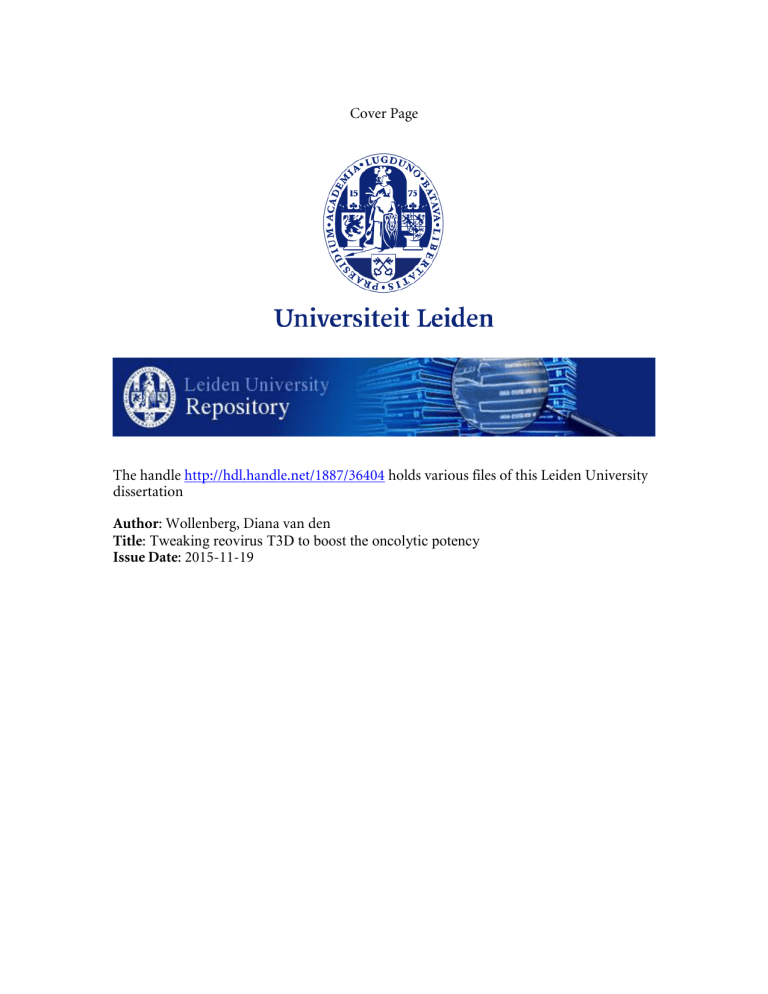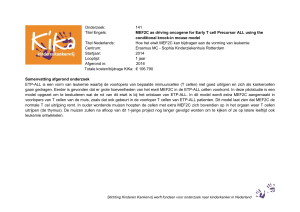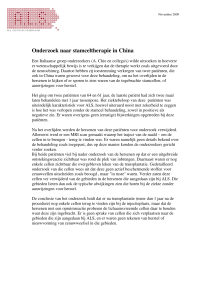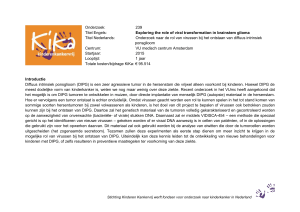
Cover Page
The handle http://hdl.handle.net/1887/36404 holds various files of this Leiden University
dissertation
Author: Wollenberg, Diana van den
Title: Tweaking reovirus T3D to boost the oncolytic potency
Issue Date: 2015-11-19
Addendum
ADDENDUM
Contents Addendum
Summary163
Nederlandse samenvatting165
List of publications168
Curriculum vitae171
162
Tweaking Reovirus T3D to Boost the Oncolytic Potency
In the war against cancer many viruses have been tried as bullets. Even viruses
that cause diseases in humans have been adapted to destroy cancer cells. Such
­viruses were rendered less pathogenic and thereby reduced their fitness and
­reproductive capacity. Some viruses discriminate by default between normal cells
and transformed cells: such viruses are named ‘oncolytic viruses’. They preferentially infect, multiply and destroy transformed cells for their release and dispersion to the surrounding cells. One of these viruses is the mammalian orthoreo­
virus T3D, or reovirus, in short. Chapter 1 gives an introduction on the characteristics of reoviruses and their potential use as oncolytic agents.
Cancer cells have developed various strategies to escape control of normal
­regulators in tissue. This may have consequences for oncolytic viruses if their
strategy involves evading cell death pathways. For their anti-tumour effect oncolytic viruses need to attach to receptors on the surface of the cell before their entry
into the cell. In some tumour cells the canonical reovirus receptors may not
always available. Reovirus cell entry is a multiple step process. The first step
involves attaching to sialic-acid residues on the cell surface. It is followed by a
higher affinity binding to Junction Adhesion Molecule-A (JAM-A). Chapter 2
describes the isolation of reovirus mutants that are able to infect cells that lack
JAM-A, the JAM-A independent (in short: jin) reovirus mutants. The jin mutants
harbour mutations in the S1 segment resulting in amino acid changes in the tail of
the spike protein σ1, and in two mutants (jin-1 and jin-2), also in the head domain
­region. The changes in the three jin mutants in the tail of σ1 are located in close
proximity of the region that is implicated in sialic-acid binding. Our hypothesis is
that the changed affinity for sialic-acids underlies the expanded tropism of the jin
viruses. The question remains how important this is in tumours in vivo.
The tumour microenvironment in vivo differs strongly from the conditions in
cell culture. This is noticeable when cells are grown as spheroids. Chapter 3
­reveals that JAM-A is dispensable for reovirus infection when cells are grown in a
3D cultures. The U118MG cells that are reovirus resistant under normal cell
­culture conditions, due to the absence of JAM-A, are susceptible to reovirus infection when grown in spheroid cultures. The increased infection is mediated by the
presence of extracellular cathepsins in the U118MG spheroids. Cathepsins are proteases that can convert the reovirus particles to so-called intermediate subviral
particles (ISVPs). ISVPs have been described to be capable of infecting cells independent of the JAM-A receptor.
The tumour microenvironment contains many proteases secreted by the
­tumour cells. These proteases promote tumour progression by modulation of key
163
ADDE NDU M
Summary
ADDENDUM
processes such as angiogenesis, metastasis, and composing the extra-cellular
­matrix (ECM). The presence of proteases in tumour could be enhance reovirus
­infection and replication.
Genetic modification of the segmented dsRNA genome of reoviruses is more
complicated than modification of dsDNA viruses such as Herpes Simplex virus or
Adenovirus. Based on previous research in the group on Adenovirus and modifications to its capsid proteins to expand the tropism, Chapter 4 describes the modification of the reovirus S1 segment that encodes for the spike protein σ1 in the
viral capsid. This approach requires the presence of wild-type reovirus to rescue
the genetically modified virus. The only segment that was changed is S1 and
­included the codons for a 6xHis-tag at the 3’end of the open reading frame for the
σ1 protein. Our results demonstrate that the C-terminus of σ1 is a suitable
­location for adding heterologous peptides and that the S1His segment stably
­delivered with a lentivirus into 911 cells is encapsulated in the reovirus particles.
A drawback of this system is the presence of wild-type reovirus necessary to
­provide the other reovirus segments. Although a selection system is used that
­consists of cells that are resistant to wild-type reovirus and are only sensitive to
the His-tagged reovirus, the mutation rate of this dsRNA viruses interferes with
the reliability of the system and the chance that revertant viruses are isolated is
­relatively high (see Chapter 2).
In 2007 a plasmid-based reverse genetics system for mammalian reoviruses
was described which allowed generation of recombinant reoviruses without the
requirements of wild-type reovirus as a helper. In Chapter 5, this system was
used for generating a recombinant reovirus that carries a gene that encodes for a
small fluorescent protein (called iLOV) and replaces the head domain of the σ1
protein. The choice for this location was based on the knowledge that the jin-3
virus, with only one point mutation in the tail of σ1, efficiently infects cells independent of the JAM-A receptor. The S1His-2A-iLOV segment encodes the first 252
amino acids of σ1, including the point mutation in the tail of jin-3 σ1 which lead to
the G196R substitution fused to the His-tag and a teschovirus-1 2A peptide that
ensures the synthesis of a separated iLOV protein in infected cells. The data presented in this chapter demonstrate for the first time that σ1 tolerates replacement
of the head domain of the spike protein by a small heterologous proteins. With
this system, next generation reoviruses could be generated that are armed with
therapeutic transgenes to enhance the oncolytic efficacy of these viruses.
Finally, Chapter 6 provides a general discussion on some of the aspects
involved in reovirus entry of cells and the immune response in men and mice.
164
Tweaking Reovirus T3D to Boost the Oncolytic Potency
Nederlandse samenvatting
Om de strijd te winnen in de oorlog tegen kanker worden zelfs virussen
­ ebruikt als kogels. Ook virussen die ziekten kunnen veroorzaken bij de mens: zij
g
worden zodanig aangepast dat ze kankercellen vernietigen en minder ziekteverwekkend zijn. Dit heeft soms tot gevolg dat deze virussen minder levensvatbaar
zijn en zich slechter kunnen vermenigvuldigen. Een aantal virussen is van nature
in staat om te discrimineren tussen gezonde cellen en kankercellen: de zogenoemde oncolytische virussen. Deze virussen vermenigvuldigen zich voornamelijk in de kankercellen en bij de ontsnapping uit de cellen waarbij deze cellen
worden vernietigd. Eén van die virussen is “Mammalian Orthoreovirus T3D”,
hier verder reovirus genoemd. Hoofdstuk 1 geeft een inleiding in de biologie van
reovirussen en hoe ze worden ingezet bij behandeling van kanker. Kankercellen
hebben strategieën ontwikkeld om aan de normale regulatoren van celdeling te
ontsnappen. Dit heeft ook gevolgen voor de oncolytische virussen als kanker­
cellen niet meer reageren op prikkels voor celdood, waar virussen op rekenen in
hun strategie om te ontsnappen uit de cellen.
Voordat de oncolytische virussen een anti-tumor effect kunnen veroorzaken
zullen de virussen eerst de cellen binnen moeten komen. Dit doen virussen door
te hechten aan bepaalde receptoren die aanwezig zijn op de oppervlakten van de
cellen. Helaas zijn niet bij alle typenkanker deze receptoren aanwezig. Het reo­
virus komt de cellen binnen met een proces dat meerdere stappen kent. Als eerste
bindt het reovirus aan siaalzuren die op de oppervlakte van cellen aanwezig zijn
om vervolgens aan de “echte” receptor te binden, genaamd JAM-A (Engelse
­afkorting voor Junction Adhesion-Molecule A). In hoofdstuk 2 wordt beschreven
hoe reovirus mutanten werden geïsoleerd die in staat zijn om cellen te infecteren
die geen JAM-A receptor bevatten; deze aangepaste reovirussen worden jinmutan­ten genoemd. Jin staat voor JAM-A onafhankelijk (JAM-A independent). Jin
reovirussen bevatten puntmutaties in het S1 genoom. Deze leiden tot aminozuur
veranderingen in het σ1 eiwit, verantwoordelijk voor hechting van de reovirussen
aan de cellen. De drie geïsoleerde jin reovirussen hebben veranderingen in de
staart van het σ1 eiwit en twee van de drie (jin-1 en jin-2) ook nog in het kop­
domein. De veranderingen in de staart van σ1 liggen allemaal in de buurt van de
regio die verantwoordelijk wordt gehouden voor de binding aan siaalzuren op
het celoppervlake. Onze hypothese is dat de jin reovirussen zich sterker binden
aan siaalzuren door deze veranderingen en daardoor meer verschillende gastheer-
165
ADDE NDU M
‘Sleutelen aan Reovirus T3D om de Oncolytische Effectiviteit te Verhogen’
ADDENDUM
cellen kunnen infecteren, ook aan de cellen die geen JAM-A receptor hebben. De
vraag blijft of dit in tumoren van het menselijk lichaam ook geldt.
Het micromilieu in tumoren is anders dan van cellen die in het laboratorium
op plastic worden gekweekt. Er is al een verschil waarneembaar als cellen in 3D
klompjes (spheroids) worden gegroeid. Hoofdstuk 3 geeft aan dat JAM-A niet
nodig is voor het infecteren van U118MG spheroids door reovirus. Onder normale
celkweek omstandigheden kan reovirus, door het ontbreken van JAM-A, de
U118MG cellen niet infecteren, maar in de 3D spheroids zijn deze cellen ineens
wel gevoelig voor reovirusinfectie. Een verklaring voor de verhoogde gevoeligheid is de aanwezigheid van bepaalde enzymen die in staat zijn om andere eiwitten af te breken, cathepsins. Cathepsins behoren tot een groep enzymen die in
staat zijn om reovirussen af te breken tot zogenoemde ISVPs (Intermediate Sub­
viral Particles). Een eigenschap van deze ISVPs is dat het binnendringen van
­cellen onafhankelijk is van de aanwezigheid van JAM-A op het celoppervlak. In
het micromilieu van tumoren is bekend dat veel van dit soort enzymen (proteases
in dit geval) aanwezig zijn. De proteases zijn mede verantwoordelijk voor de
­ontwikkeling van de tumor naar een agressievere vorm door bijvoorbeeld het aanleggen van bloedvaten (angiogenese), en hebben een rol bij het vermogen om te
metastaseren en ze zijn belangrijk voor het remodeleren van de extracellulaire
­matrix van de tumor. De aanwezigheid van deze proteasen kunnen reovirussen
helpen om de tumorcellen binnen te komen.
Genetische modificatie van het reovirus genoom is door de aanwezigheid van
meerdere dsRNA segmenten een stuk moeilijker dan bij dsDNA virussen, zoals
bijvoorbeeld herpes simplex virus en adenovirus. Gebaseerd eerder ervaringen in
ons lab met het modificeren van adenoviruscapside eiwitten om het tropisme te
veranderen wordt in hoofdstuk 4 beschreven hoe het S1 segment van reovirus
­genetisch wordt veranderd. S1 codeert voor het capside eiwit σ1, dat de spike
vormt waarmee het virus de JAM-A receptor bindt. Om het veranderde reovirus
te vermenigvuldigen is er echter wild-type reovirus nodig. Het enige segment dat
wordt veranderd is S1. Hier wordt de sequentie coderend voor een 6xHis-tag
­geplaatst dat er zo voor te zorgen dat aan de C-terminus van het σ1 eiwit een Histag vast zit. De experimenten tonen aan dat deze locatie geschikt is voor het aanbrengen van heterologe peptiden en dat het S1His genoom dat wordt aangeleverd
door een 911 cellijn die was getransduceerd met een lentivirus, wordt ingepakt in
de nieuwe reovirussen. Een nadeel van het systeem is dat er wild-type reovirus
nodig is om de andere negen segmenten te leveren. Ondanks het gebruik van een
selectiesysteem tegen het wild-type reovirus is de hoge mutatiesnelheid van reovirus een bedreiging voor de betrouwbaarheid van dit systeem, waardoor de kans
op het ontstaan van mutanten toeneemt (zie ook hoofdstuk 2).
166
Tweaking Reovirus T3D to Boost the Oncolytic Potency
ADDE NDU M
Het beschikbaar komen van een plasmide systeem voor het modificeren van
reovirus (in 2007) heeft ertoe geleid dat er geen wild-type reovirus meer nodig is.
In hoofdstuk 5 is dit systeem gebruikt voor het maken van een recombinant reo­
virus met een S1 segment waarin het coderende gedeelte voor het kopdomein van
σ1 wordt vervangen door de codons van een klein fluorescerend eiwit (iLOV). De
keuze van deze locatie kwam voort uit de kennis dat jin-3, met maar één
­aminozuursubstitutie in de staart van σ1, niet langer JAM-A nodig heeft om cellen
­binnen te komen. Het nieuwe S1His-2A-iLOV segment codeert de sequentie voor
de eerste 252 aminozuren van σ1, met de puntmutatie resulterend in de G196R
verandering, gefuseerd aan de codons voor een His-tag en die voor het tescho­
virus-2A peptide dat ervoor zorgt dat het iLOV eiwit wordt gescheiden van het
σ1-His eiwit. Uit de gegevens van dit hoofdstuk blijkt voor het eerst dat σ1 de
toevoeging van een klein heteroloog eiwit tolereert en daarbij het hoofddomein
niet nodig heeft. Met deze kennis is het mogelijk om nieuwe generaties reovirussen te maken die gewapend zijn met therapeutische genen die de oncolytische
effectiviteit kunnen verhogen.
Het laatste hoofdstuk, hoofdstuk 6, vat de algemene conclusies samen en
­bespreekt een aantal onderdelen die van belang zijn bij het binnenkomen van de
reovirussen in cellen en de reactie van het immuunsysteem op de aanwezigheid
van reovirus in mensen en muizen.
167
ADDENDUM
List of publications
1. Van den Wollenberg D.J.M., Hoeben R.C., Van Ormondt H., Van der Eb A.J.
Insertion of the human cytomegalovirus enhancer into a myeloproliferative
sarcoma virus long terminal repeat creates a high-expression retroviral vector.
Gene. 1994;144(2):237-241.
2. Hoeben R.C., Fallaux F.J., Cramer S.J., Van den Wollenberg D.J.M., ­­
Van Ormondt H., Briët E., et al. Expression of the blood-clotting factor-VIII
cDNA is repressed by a transcriptional silencer located in its coding region.
Blood. 1995;85(9):2447-2454.
3. Fallaux F.J., Hoeben R.C., Cramer S.J., Van den Wollenberg D.J.M., Briët E.,
Van Ormondt H., et al. The human clotting factor VIII cDNA contains an
­autonomously replicating sequence consensus- and matrix attachment
­region-like sequence that binds a nuclear factor, represses heterologous gene
expression, and mediates the transcriptional effects of sodium. Mol Cell Biol.
1996;16(8):4264-4272.
4. Fallaux F.J., Bout A., Van der Velde I., Van den Wollenberg D.J.M., Hehir
K.M., Keegan J., et al. New helper cells and matched early region 1-deleted
adenovirus vectors prevent generation of replication-competent adenoviruses.
Hum Gene Ther. 1998;9(13):1909-1917.
5. Pietersen A.M., Van der Eb M.M., Rademaker H.J., Van den Wollenberg
D.J.M., Rabelink M.J., Kuppen P.J., et al. Specific tumor cell killing with
­adenovirus vectors containing the apoptin gene. Gene Ther. 1999;6(5):882-892.
6. Geutskens S.B., Van den Wollenberg D.J.M., Van der Eb M.M., Van
Ormondt H., Jochemsen A.G., Hoeben R.C. Characterisation of the p53 gene
in the rat CC531 colon carcinoma. Gene Ther Mol Bio. 2000;5:81-86.
7. Ossevoort M., Visser B.M., Van den Wollenberg D.J.M., Van der Voort E.I.,
Offringa R., Melief C.J., et al. Creation of immune ‘stealth’ genes for gene
therapy through fusion with the Gly-Ala repeat of EBNA-1. Gene Ther.
2003;10(24):2020-2028.
168
Tweaking Reovirus T3D to Boost the Oncolytic Potency
8. Vellinga J., Rabelink M.J.W.E., Cramer S.J., Van den Wollenberg D.J.M.,
Van der Meulen H., Leppard K.N., et al. Spacers increase the accessibility of
peptide ligands linked to the carboxyl terminus of adenovirus minor capsid
protein IX. J Virol. 2004;78(7):3470-3479.
9. Smakman N., Van den Wollenberg D.J.M., Borel Rinkes I.H.M., Hoeben
R.C., Kranenburg O. Sensitization to apoptosis underlies KrasD12-dependent
oncolysis of murine C26 colorectal carcinoma cells by reovirus T3D. J Virol.
2005;79(23):14981-14985.
10. Vellinga J., Van den Wollenberg D.J.M., Van der Heijdt S., Rabelink
M.J.W.E., Hoeben R.C. The coiled-coil domain of the adenovirus type 5
­protein IX is dispensable for capsid incorporation and thermostability. J Virol.
2005;79(5):3206-3210.
11. Rademaker H.J., Fallaux F.J., Van den Wollenberg D.J.M., De Jong R.N.,
Van der Vliet P.C., Hoeben R.C. Relaxed template specificity in fowl
­adenovirus 1 DNA replication initiation. J Gen Virol. 2006;87(Pt 3):553-652.
12. Smakman N., Van den Wollenberg D.J.M., Elias S.G., Sasazuki T.,
­Shirasawa S., Hoeben R.C., et al. KRAS(D13) Promotes apoptosis of human
colorectal tumor cells by ReovirusT3D and oxaliplatin but not by tumor
­necrosis factor-related apoptosis-inducing ligand. Cancer Res.
2006;66(10):5403-5408.
13. Smakman N., Van den Wollenberg D.J.M., Veenendaal L.M., Van Diest P.J.,
Hoeben R.C., Borel Rinkes I.H.M., et al. Human colorectal liver ­metastases
are resistant to Reovirus T3D and display aberrant localization of the reovirus
receptor JAM-1. Oncogene. 2006:147-158.
ADDE NDU M
14. Smakman N., Van der Bilt J.D.W., Van den Wollenberg D.J.M., Hoeben
R.C., Borel Rinkes I.H.M., Kranenburg O. Immunosuppression promotes
reovirus therapy of colorectal liver metastases. Cancer Gene Ther.
2006;13(8):815-818.
15. Van den Wollenberg D.J.M., Van den Hengel S.K., Dautzenberg I.J.C.,
­Cramer S.J., Kranenburg O., Hoeben R.C. A strategy for genetic modification
of the spike-encoding segment of human reovirus T3D for reovirus targeting.
Gene Ther. 2008;15:1567-1578.
169
ADDENDUM
16. Van Houdt W.J., Smakman N., Van den Wollenberg D.J.M., Emmink B.L.,
Veenendaal L.M., Van Diest P.J., et al. Transient infection of freshly isolated
human colorectal tumor cells by reovirus T3D intermediate subviral particles.
Cancer Gene Ther. 2008;15(5):284-292.
17. Van den Wollenberg D.J.M., Van den Hengel S.K., Dautzenberg I.J.C.,
­Kranenburg O., Hoeben R.C. Modification of mammalian reoviruses for use
as oncolytic agents. Expert Opin Biol Ther. 2009;9(12):1509-1520.
18. Van den Hengel S.K., Dautzenberg I.J.C., Van den Wollenberg D.J.M., Smitt
P.a.E.S., Hoeben R.C. Genetic Modification in Mammalian Ortho­reoviruses.
Reverse Genetics of RNA Viruses: John Wiley & Sons, Ltd; 2012. p. 289-317.
19. Van den Wollenberg D.J.M., Dautzenberg I.J.C., Van den Hengel S.K.,
­Cramer S.J., De Groot R.J., Hoeben R.C. Isolation of reovirus T3D mutants
­capable of infecting human tumor cells independent of Junction Adhesion
­Molecule-A. PLoS ONE. 2012;7(10):e48064
20. Van den Hengel S.K., Balvers R.K., Dautzenberg I.J., Van den Wollenberg
D.J.M., Kloezeman J.J., Lamfers M.L., et al. Heterogeneous reovirus
­susceptibility in human glioblastoma stem-like cell cultures. Cancer Gene
Ther. 2013;(20):507-513.
21. Dautzenberg I.J., Van den Wollenberg D.J.M., Van den Hengel S.K.,
­Limpens R.W., Barcena M., Koster A.J., et al. Mammalian orthoreovirus
T3D infects U-118 MG cell spheroids independent of Junction Adhesion
­Molecule-A. Gene Ther. 2014;21:609-617.
22. Van den Wollenberg D.J.M., Dautzenberg I.J., Ros W., Lipinska A.D.,
Van den Hengel S.K., Hoeben R.C. Replicating reoviruses with a transgene
­replacing the codons for the head domain of the viral spike. Gene Ther.
2015;22(3):51-63.
170
Tweaking Reovirus T3D to Boost the Oncolytic Potency
Curriculum vitae
Diana van den Wollenberg is geboren op 3 maart 1969 in Tilburg. Na het
­ oorlopen van de Beatrix MAVO in Tilburg werd in 1985 begonnen aan de HLO
d
opleiding Medische Biochemie aan de Hogeschool West-Brabant (Dr. Struycken
Instituut) in Etten-Leur, waarvan het eerste jaar in een speciale schakelklas
­MLO-HLO. De opleiding werd afgesloten in 1990 met een stage bij het Nederlands Kanker Instituut, Sectie Celbiologie, onder begeleiding van Dr. J. Collard.
In juli 1990 werd ze aangenomen als analist bij de sectie Moleculaire Carcinogenese van de Universiteit Leiden. Zij ging werken in de groep van Prof. Dr. A.J.
van der Eb en werd ingezet bij het promotieonderzoek van R.C Hoeben (inmiddels Prof.) naar gentherapie voor hemofilie A. In de loop van de jaren werd de
­nadruk van het onderzoek steeds meer gelegd op de ontwikkeling van nieuwe
virale vectoren voor gebruik in gentherapie en in oncolytische behandelingen.
­Inmiddels was de sectie Moleculaire Carcinogenese opgegaan in de afdeling
­Moleculaire Celbiologie onder leiding van Prof. Dr. H.J. Tanke en werd de
­Medische faculteit ondergebracht bij het Leids Universitair Medisch Centrum.
Eind jaren 90 heeft ze meegewerkt aan de ontwikkeling van de helpercellijn PER.
C6 (Crucell) om adenovirus vectoren op te groeien. In 2005 werden de reovirussen
geïntroduceerd binnen de Virus- en Stamcelbiologiegroep.
Naast het onderzoek is ze, sinds 2006, actief binnen het LUMC in de medezeggenschap, eerst als lid van de onderdeelcommissie divisie 5 (OC5), later als
duo-voorzitter van OC5 en momenteel als duo-voorzitter van de onderdeel­
commissie behorende bij divisie 4 (OC4).
ADDE NDU M
Vanaf 2008 heeft ze het promotieonderzoek verricht dat is beschreven in dit
proefschrift.
171
ADDENDUM
172











